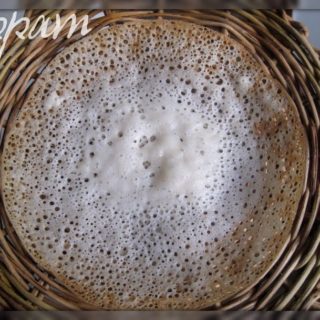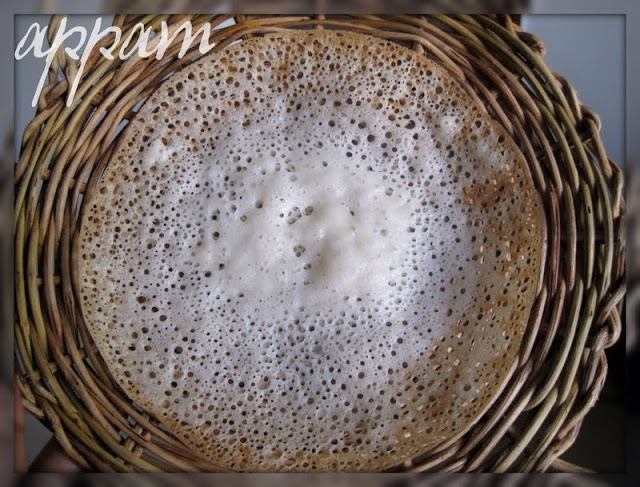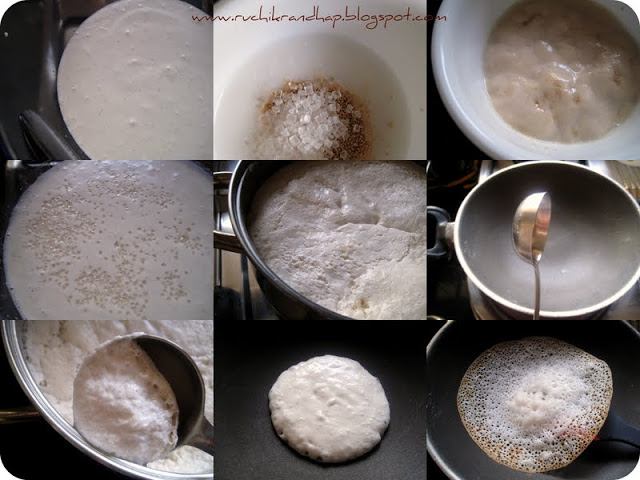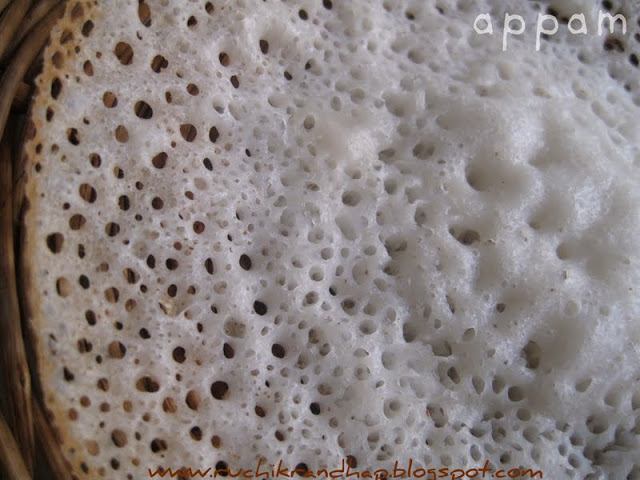Whenever homesickness crept into the first couple of years of my marriage, I would just close my eyes and imagine the comforting flavours & fragrances of my mom’s kitchen in my home back in Mangalore. A kitchen filled with the sweetish aroma of fermenting batter – especially for Appams (‘Appaan’ is it’s nasal pronounciation in Konkani) is something I vowed to recreate in my kitchen. Mum’s collection of recipes (a little tattered diary dated 1986) helped me understand the proportions of rice used in addition to the science & art of cooking. Appams were usually made only for special occasions – birthdays or when dinner was hosted for guests (especially those who came from abroad). The giant stone grinder would grind away the rice & coconut as mum prepared the yeast.
Before yeast became the most common & convinient fermenting agent, it was sweet toddy procured from – my guess is Arack shops. I always waited patiently for mum to prepare this kind of a sweet fermented ‘dosa’ cum ‘idli’ combo and enjoyed bite after bite especially the crispy frill.
Appams can delight anyone – young or old, especially those who are health conscious as its preparation does not involve the use of oil for frying.
I am glad I am able to make decent appams today so that my little one can enjoy it just the way I did.
Appam placed on a traditional ‘kurpon’ woven out of reeds
Appams
Recipe Source: My mum
You Need:
For the batter:
- 1 cup raw rice (called as Surai in Mangalore, I use Kollam rice in Mumbai – its a small grained rice)
- 1/2 cup boiled rice (called as Ukdo in Konkani, Ukda in Hindi & Marathi, Katsambar in Kannada)
- 1/2 cup grated coconut (about a fistful) (or you can add 2 tbsps coconut milk powder)
- 1 handful or half a cup cooked rice – optional (this makes your appams ultra soft!)
- 2 level tsps sugar (plus 1 tsp if you like your appams a little sweetish)
- 1 tsp salt or to taste
To prepare the yeast for fermentation
- 1 tsp active dried yeast (I use DCL brand which is famous in the Gulf)
- 1 tsps sugar (this helps the yeast to dissolve faster & turn frothy and in turn aids fermentation)
- 1/2 cup of lukewarm water
Method:
Soak each rice separately for at least 3 hours (overnight is better). Gring both fine along with the grated coconut and cooked rice (optional). Add water as you grind, but leave the consistency to be that of dosa batter and not too thin like neer dosa
Put the batter in a large pan (so that the batter doesnt spill over during fermentation) & keep aside. To prepare the yeast – add the 1 tsp of yeast plus the 1 tsp of sugar in a bowl of lukewarm water. Set aside for 5-10minutes and you will see that the yeast has dissolved & turned a frothy mixture of a dull brownish pink colour. Add this to the batter, stir well & add the salt to taste. Add some water to achieve dosa batter kind of consistency. You cannot add water after the batter has fermented because the dough would have risen and if you stir it once it has, the dough will just fall flat.
Cover the pan with thin muslin cloth (or bairas as it’s called in Konkani) and keep in a warm place for fermentation. Depending on the climate and the quality of yeast used, the batter should ferment & double in a span of 1 1/2 – 2hours.
No warm weather where you live? I have heard a lot of friends lament about this. Do not fret my friend! If you own an oven which has a ‘keep warm’ mode (my OTG does), just turn the oven temperature to minimum & set the timer to 10minutes on ‘Keep Warm’ mode. Warning! Dont set it on bake/grill mode or else you’l have cakes instead of appams!! I tried it for the first time today & it worked beeeeautifully! In almost 90 minutes I had the pan full of risen dough! Just make sure you check on the timer, if you feel it has become too hot, turn it off & redo this step again after 30minutes (No! its not as complicated as it sounds)
When the dough has doubled do not shake the vessel or place it on a surface with a thud. Be gentle!
Alternately heat a non-stick deep bottomed skillet (appanchi kaail as it’s called in Konkani – You can buy one in Kamath & Co in Hampankatta, Mangalore. Just ask for Appam kadai. If you dont have one, you can use a deepish wide non stick kadai/wok with handles on each side.) and pour one ladle full of batter right in the centre of the it. Wait for 4-5 seconds (so that the centre remains like a fluffy idli) and then holding both the handles of the kadai twirl it around just once until the batter spreads around the centre like a fluffy frill. Place it back on the stove. Cover & cook on medium heat for about 90 seconds.
Tip! : I am told that the appams dont ‘lift’ well the next time around if you use its kadai for anything besides making appams – so ideally, do not use it for anything else.
Your appam is done when the centre looks cooked (translucent) and the frill is golden in colour (NOT brown, just a pale golden). Remove gently with a wooden/rubber spatula and place in a hot box (serving casserole).

Appams
Appams are slightly sweetened and fermented rice batter pancakes with crisp frilly edges that are traditional made in coastal Karnataka and Kerala. They taste best when served with chicken or egg stew or any veg or non veg accompaniment or chutney
Print
Pin
Rate
Ingredients
For the batter:
- 1 cup raw rice * see notes
- 1/2 cup boiled rice *see notes
- 1/2 cup grated coconut
- ½ cup cooked rice – optional
- 2 teaspoons granulated white sugar plus 1 tsp if you like your appams a little sweetish
- 1 tsp salt or to taste
For the yeast solution:
- 1 tsp active dried yeast
- 1 tsp sugar
- 1/2 cup of lukewarm water
Instructions
- Soak each type of rice separately for at least 3 hours (overnight is better). Grind both of them together with the grated coconut and cooked rice (optional). Add a tablespoon of water or as required to achieve a thick, dosa batter like consistency. Do not dilute it too much. Transfer the batter into a large pot
- Activate the yeast by mixing all the ingredients mentioned under ‘For the yeast solution’ in a small bowl or cup. Cover and set aside for 10-12 minutes or till the mixture looks frothy. If it hasn’t turned frothy it is probably old or has expired. Discard it and start again with a new pack of yeast.
- Add the activated yeast solution to the batter, salt to taste and enough water to make the batter thick and flowing. Mix well using your hand. Then cover the pan and place in a warm place for fermentation. Depending on the climate and the quality of yeast used, the batter should ferment & double in a span of 1 1/2 – 2hours.
- When the batter has doubled, heat an appam kadai or a small/deep wok and pour one ladle full of batter right in the centre of it. Wait for 4-5 seconds (so that the centre remains like a fluffy idli) and then holding both the handles of the kadai twirl it around just once until the batter spreads around the centre like a fluffy frill. Place it back on the stove. Cover & cook on medium heat for about a minute and a half
- Your appam is done when the centre looks cooked (translucent) and the frill is light golden in colour Remove gently with a wooden/rubber spatula and place in a hot box (serving casserole).
- Serve hot!! It is probably the most versatile Indian bread as you can eat it with Chicken/Veg stew, Pork Indad, Chicken Curry or even with coconut chutney (for breakfast)
Notes
Raw rice is called as Belthige/Surai Tandu in Mangalore, I use Kollam rice, a small grained rice which also works well.
Boiled rice is called as Katsambar/Ukdo Tandu in Mangalore
Instead of the grated coconut you can also add 2 tbsps coconut milk powder
Appams dont ‘lift’ well the next time around if you use its kadai for anything besides making appams – so ideally, do not use it for anything else.
Adding the cooked rice makes your appams ultra soft!
No warm weather where you live? If you own an oven which has a ‘keep warm’ mode (my OTG does), just turn the oven temperature to minimum & set the timer to 10minutes on ‘Keep Warm’ mode. Just make sure you check on the timer, if you feel it has become too hot, turn it off & redo this step again after 30minutes.
Boiled rice is called as Katsambar/Ukdo Tandu in Mangalore
Instead of the grated coconut you can also add 2 tbsps coconut milk powder
Appams dont ‘lift’ well the next time around if you use its kadai for anything besides making appams – so ideally, do not use it for anything else.
Adding the cooked rice makes your appams ultra soft!
No warm weather where you live? If you own an oven which has a ‘keep warm’ mode (my OTG does), just turn the oven temperature to minimum & set the timer to 10minutes on ‘Keep Warm’ mode. Just make sure you check on the timer, if you feel it has become too hot, turn it off & redo this step again after 30minutes.
Disclaimer
The nutritional values are only indicative.
Tried this recipe?Please leave a comment & rate the recipe below or share a photo on Instagram and tag me @ruchikrandhap



Shireen, you are killing me softly with this blog…:D 😀
OMG, I love appams. Sadly since we have an induction range it is very difficult to cook here, as we can't get the crispy sides. I miss it so much.
May:All this is for people like u & me – away from home 🙂
Michelle: I havent worked with an induction range, so i am not sure how that works, but i do hope u get to eat some (if not make them) real soon! I know how it feels to stay away from home & not get to eat ur fav comfort food 🙁
Can you give us a pork indad recipe. Thanks.
Hi Tipsi, I haven't tried making pork indad yet as we don't get good pork closeby, will do so especially for u..pls give me some time, thanks!!
Shireen,
You do not seem to have a recipe for pork and chicken indad on your site… even though it is mentioned with the appams above.. 🙂
Lyn
Lyn: Yes I don't have the recipes which is why I didnt provide any link 🙂 I just mentioned the serving suggestion and that appams do taste great with pork indad & chicken curry (not indad). I have several chicken curry recipes, but didn't link them here 🙂
Shireen, thank you so much for this website. I too am a Mangalorean now living in Madurai, Tamilnadu. Your website is a Godsend. I plan to try out a lot of your recipes, which make cooking seem so easy.
Annabel.
Hi Shireen, Wow! Amazing recipes. I am inspired to try out the mangalorean recipes after all these years of not wanting to. As a kid I would not really like eating the mangalorean delicacies like mandas etc. But now that I stay away from home..I crave for it.I tried out appams today and I am glad I did. Well, mandas is next on my list 🙂
Thank you for your inspiring website.
Tracy
im staying in bangalore. now its cold here. may b because of that or what ,dnt know my appam batter is not fermenting. wat should i do?i dont have oven also
Hi Sitara, you can try placing the pan of batter over a pan with boiled water and place another hot pan over the pan of batter (be careful so it doesnt topple) – something like a sandwich so it gets the heat
Hi Ruchik,
I am new to your blog. And I just want to say that your recipes are very easy t follow.
And the dish turns our just as it is in the photos.
Thanks for sharing your recipes with us.
If I want to use the batter the next day, once it's fermented can I put it into the fridge? Also I've seen sometimes it rises and then becomes flat why is that ??
If I want to use the batter the next day, can it be put in the fridge? Also why does the batter rise n then fall flat??
Akira: You can use the batter the next day once it has fermented fully. The batter rises when the yeast works. Once it has reached its full potential (of rising) it will fall. If you keep it at room temperature for too long after it has risen and fallen the batter will turn sour, so once it has risen, refrigerate it and then you can use it the next day. Just keep it out from the fridge for an hour or so before you fry the appams
I almost wrote Hi Ruchik!! 😛
Shireen, this has been my go to recipe for the past 3 years and today I realised that I havent let you know of this fact.my bad. So here goes, Thank you my dear! Keep up the good work! The appams turn out fantastic! <3
HI Shireen
I app are appams ages ago and am planning to try it again.
I am a mangalorean living in Toronto.
Please advice the types of rice and yeast I can use for this recipe.
Thanks
Kathy
Hi Kathy,
You can check your Indian store for white rice and boiled rice varieties. If you have a store run by Malayalis there are higher chances of finding what you want. Basmati or sona masoori or kolam rice are white rice varieties while polished ‘matta’ rice is a boiled rice variety. You can use instant or active dry yeast
I am a ma golden living in Toronto , Canada.
Not sure if I can get the various rice called for in your recipe….or what are the alternatives .
Also what Type of yeast to use…most popular here is flieschmans. Will this do and how do I work with thus.
Please advice on both above.
Thanks
Hi,
You can use basmati rice where the recipe calls for raw rice. For the boiled rice, you can check your nearest Indian store. There is no substitute for this. I have not heard of the brand of yeast you mentioned but any good dried yeast will do. Please activate it by mixing it with a little warm water and sugar. Cover & keep aside for 10 minutes till it froths up. If it doesn’t, then maybe its old. Discard and use a new package. Hope these tips help. Do revert if you still have any doubts
My appam turned out very good ..at first i was scared to try as i have tried so many appam recite which never fermented..this is a first time I have used with 2 varieties of rice and within 2 hrs it got fermented..i was so happy to see it …
So glad to hear that Dilavez!! Enjoy the appams!
Hi Shireen,
I tried this recipe today for Easter. The appams were really good. Thank you for the detailed recipe. Your recipes all come out perfectly. Love the way you explain everything and for your little tips.
Hi Jonita,
Thank you so much for the great feedback! Happy to know that my recipes help you so much! <3
Can I grind both the rice and leave it overnight for fermentation.
If you are using the yeast then it is not advisable to leave it overnight for fermentation as the batter could get overfermented and smell sour. With yeast, the ideal time for fermentation is approx 2 hours..
For making appams you said to use “Used Boild Rice”. Is it the rice of any variety which is already used.
Boiled rice is a variety of rice where the rice is boiled in large drums of water after being harvested. It is then dried and sold. The grain tends to be fatter and slightly creamish in colour.
Hi Shireen,
Can I just use Idli rice with urad dsl for the recipe?
This idli rice is white un colour and slightly flat.
Hi Blasilla,
I haven’t tried making with idli rice, I guess you can cuz I have heard about a lot of §